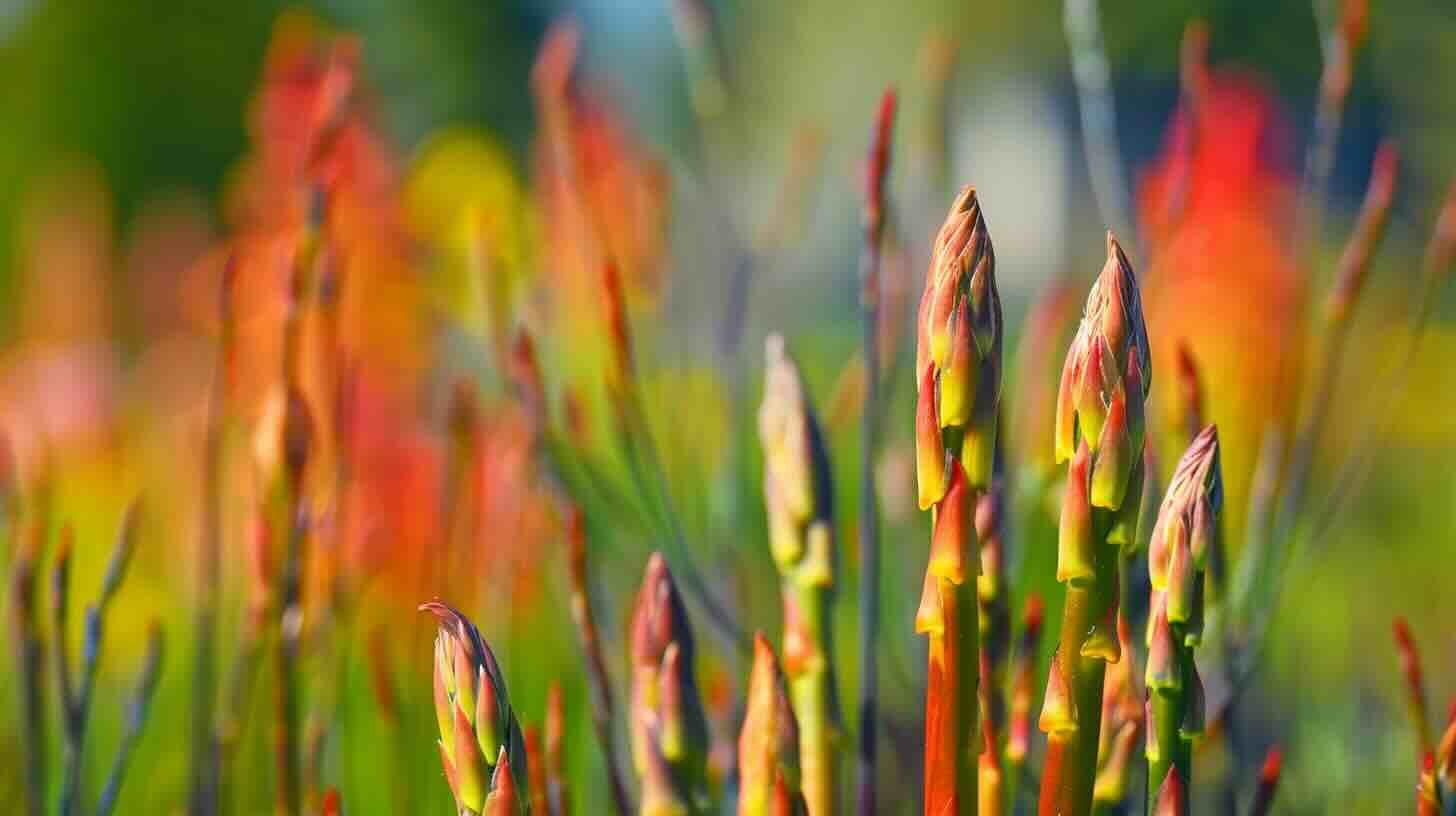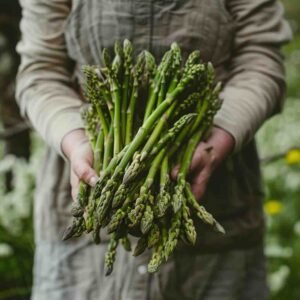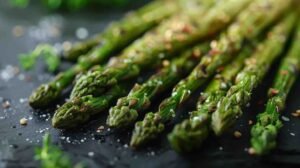Wild Asparagus: A Brief Insight
It is a plant that has a delicious taste and can be found in nature. This is a plant that grows freely and wild in many areas of the globe.
It is very much the asparagus that you eat in the stores, but it tastes a bit different and feels also different when it is in your mouth.
Those who relish on searching what they eat from nature definitely find wild asparagus a treasure.
Why Wild Asparagus Matters ?
This asparagus has two main purposes for which it is crucial.
In the first place, asparagus is loved by cooks, due to the fact that it is original and can be used in various recipes.
Secondly, folks engaged in foraging like the thrill of discovering asparagus in nature.
It’s like a happy quest for the treasure for them.
One of the best things about seeking out asparagus is the fact that it can be done either alone or with friends and family alike.
What is Wild Asparagus?
It is a unique plant that is different from the asparagus you usually see in the grocery store. In this section, we will explore what makes wild asparagus special.
The Science Behind Asparagus
Wild asparagus has a scientific name, which is Asparagus officinalis. It belongs to the same family as the asparagus you find in stores, but it grows naturally in the wild. Wild asparagus looks similar to cultivated asparagus, but there are some differences in how they grow and taste.
Where to Find Wild Asparagus
If you want to find wild asparagus, you need to know where to look. This section will tell you about the places where wild asparagus grows and when you can find it.
Places Where it Grows
It asparagus grows in many parts of the world. You can find it in:
| Location | Description |
|---|---|
| North America | United States, Canada |
| Europe | Germany, France, United Kingdom, and more |
| Asia | China, Japan, Korea |
| Australia | Some parts of Australia |
Wild asparagus likes to grow in sunny areas with well-drained soil. You can often find it near rivers, in fields, or on the edges of forests.
The Best Time to Find this Asparagus
The best time to look for asparagus is in the spring. This is when the plant starts to grow new shoots. The exact time depends on where you live. In most places, you can find wild asparagus from April to June.
How to Identify this Asparagus ?
When you’re out looking for this asparagus, it’s important to know how to identify the plant. This section will teach you what to look for and how to avoid picking the wrong plants.
What it Looks Like ?
Wild asparagus has some unique features that make it easy to spot. Here are some things to look for:
| Plant Part | Description |
|---|---|
| Stems | Thin, green, and can grow up to 6 feet tall |
| Leaves | Small, scale-like leaves that grow directly on the stem |
| Flowers | Small, greenish-white flowers that bloom in the summer |
| Berries | Small, red berries that appear after the flowers |
Plants That Look Like Wild Asparagus
There are some plants that look similar to this asparagus but are not safe to eat. These plants include:
- Poison Hemlock
- Death Camas
- Dogbane
To avoid picking the wrong plant, always make sure to check for the unique features of asparagus. If you’re not sure, it’s better to leave the plant alone.
Sustainable Foraging Practices
When you forage for asparagus, it’s important to do it in a way that doesn’t harm the environment. This means being responsible and respectful of the plants and the places where they grow.
Why Sustainable Foraging Matters
Sustainable foraging is important because it helps to keep the environment healthy. If too many people take too much asparagus, it can make it harder for the plants to grow back. This can harm not just the wild asparagus but also other plants and animals that depend on it.
How to Forage Responsibly
Here are some tips for foraging wild asparagus in a responsible way:
| Tip | Explanation |
|---|---|
| Only take what you need | Leave some asparagus behind so it can keep growing |
| Don’t damage the plant | Be careful not to break or tear the stems when you pick the wild asparagus |
| Leave the roots | Don’t dig up the roots, as this can kill the plant |
| Respect the environment | Don’t leave trash or damage other plants while you’re foraging for asparagus |
Culinary Uses
Wild asparagus is a delicious ingredient that can be used in many different recipes. This section will give you some ideas for how to prepare and cook wild asparagus.
Preparation
Before you can cook with wild asparagus, you need to prepare it. Here are the steps:
- Wash the wild asparagus to remove any dirt or debris
- Cut off the tough, woody ends of the stems
- If the stems are thick, you can peel them with a vegetable peeler
Cooking with Wild Asparagus
There are many ways to cook wild asparagus. Here are some popular methods:
| Cooking Method | Description |
|---|---|
| Steaming | Place the asparagus in a steamer basket over boiling water |
| Sautéing | Cook the asparagus in a pan with butter or oil |
| Grilling | Toss the asparagus with oil and grill over medium-high heat |
| Roasting | Place the wild asparagus on a baking sheet and roast in the oven |
You can also add wild asparagus to soups, salads, pasta dishes, and more. Get creative and see what delicious dishes you can come up with!
Health Benefits
Not only does this asparagus taste good, but it’s also really healthy for you. In this section, we’ll explore what makes wild asparagus so nutritious.
Nutritional Benefits
Wild asparagus is not only tasty but also good for your health. It has many vitamins and minerals that your body needs. Wild asparagus is a great source of vitamin C, vitamin A, and vitamin K. These nutrients help keep your body strong and healthy. Eating wild asparagus can be a delicious way to add more nutrition to your meals.
Wild asparagus is packed with good stuff that your body needs. Here are some of the most important nutrients:
| Nutrient | Benefits |
|---|---|
| Vitamin K | Helps your blood clot and keeps your bones strong |
| Vitamin C | Boosts your immune system and helps your body heal |
| Folate | Important for pregnant women and helps make new cells |
| Fiber | Helps keep your digestive system healthy |
Wild Asparagus vs Regular Asparagus
You might wonder if wild asparagus is healthier than the asparagus you get at the store. The truth is, they’re both really good for you. Wild asparagus and regular asparagus have similar amounts of vitamins and minerals.
The main difference is that wild asparagus might have even more antioxidants. Antioxidants help protect your cells from damage. So eating wild asparagus can be a tasty way to keep your body healthy.
Cultivation of Asparagus
If you love asparagus, you might wonder if you can grow it at home. The good news is that you can! This section will tell you what you need to know about growing wild asparagus.
Can You Grow Asparagus at Home?
Yes, you can grow asparagus in your own garden. It’s not as hard as you might think. Asparagus is a perennial plant, which means it comes back every year. Once you plant it, you can enjoy fresh asparagus for many years to come.
How to Grow this type of Asparagus ?
Here are the basic steps for growing asparagus:
- Choose a sunny spot in your garden with well-drained soil
- Plant asparagus crowns (roots) in the spring
- Water the plants regularly and add mulch to keep the soil moist
- Be patient – it can take 2-3 years before you can harvest the asparagus
Growing your own asparagus can be a fun and rewarding project. Just remember that it takes time and patience. But once you start harvesting your own asparagus, you’ll see that it’s worth the wait!
This Asparagus in Different Cultures
Asparagus isn’t just popular in one place – it’s loved by people all over the world! This section will explore how different cultures use and enjoy asparagus.
The History
People have been eating asparagus for a very long time. In ancient Egypt, Greece, and Rome, asparagus was a popular vegetable. It was also used as medicine to treat different health problems.
In China, this asparagus has been used in traditional medicine for over 2,000 years. People believed it could help with digestion, kidney problems, and more.
How Different Cultures Eat this Asparagus
Different cultures have their own special ways of preparing and eating asparagus. Here are a few examples:
| Culture | Dish |
|---|---|
| Germany | Asparagus soup, asparagus with hollandaise sauce |
| France | Asparagus omelette, asparagus salad |
| Korea | Asparagus stir-fry, asparagus kimchi |
| Italy | Asparagus risotto, asparagus wrapped in prosciutto |
As you can see, this asparagus is enjoyed in many different ways around the world. It’s a versatile ingredient that can be used in all sorts of yummy dishes!
Conclusion
Wow, we’ve learned so much about sparagus! Let’s take a moment to review some of the most important points and think about what we can do with this knowledge.
What We’ve Learned About this type of Asparagus
- This asparagus is a tasty and nutritious vegetable that grows in many parts of the world
- It’s different from regular asparagus but just as healthy
- You can find asparagus in the spring by looking for its unique features
- It’s important to forage for asparagus responsibly to protect the environment
- There are many delicious ways to prepare and eat asparagus
- It has a long history and is enjoyed in different cultures around the world
Enjoying this Asparagus Responsibly
Now that you know all about this asparagus, you might be excited to go out and find some for yourself. Just remember to be respectful of the environment and only take what you need.
If you can’t find asparagus near you, don’t worry! You can still enjoy the delicious taste and health benefits of asparagus by buying it at the store or growing it in your own garden.
No matter how you enjoy it, remember that this asparagus is a special and unique vegetable that deserves to be appreciated and celebrated.





